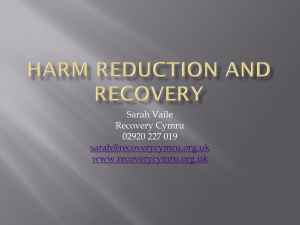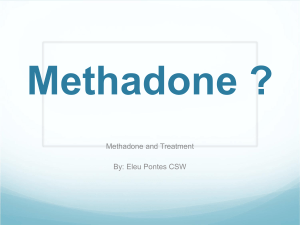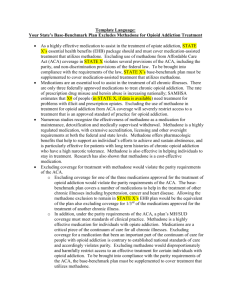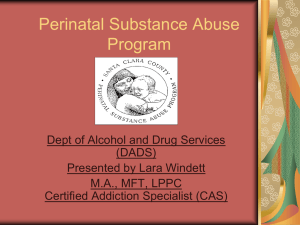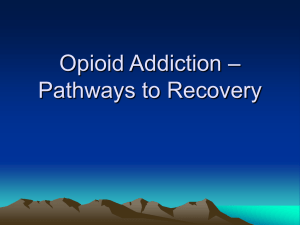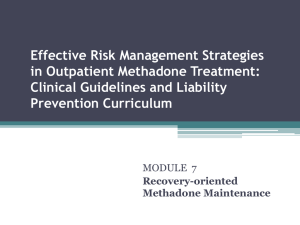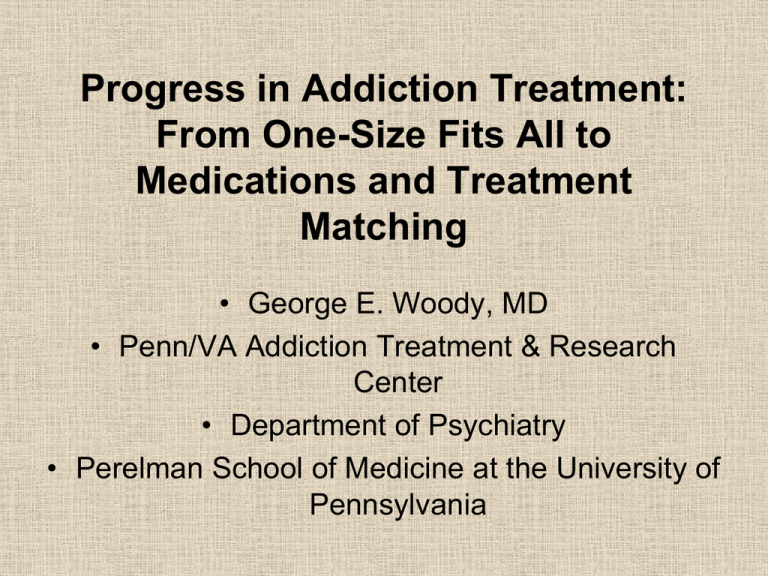
Progress in Addiction Treatment:
From One-Size Fits All to
Medications and Treatment
Matching
• George E. Woody, MD
• Penn/VA Addiction Treatment & Research
Center
• Department of Psychiatry
• Perelman School of Medicine at the University of
Pennsylvania
Disclosures
• Fidelity Capital provided naltrexone implants
(Prodetoxon®) at reduced cost in Russia
• Alkermes provided Vivitrol ® for Iceland study
• Reckitt Benckiser provided Suboxone ® for CTN
study and one in Republic of Georgia
• Janssen providing Vivitrol ® at reduced cost for
Russian study
• Career support provided by VA clinical funds
and NIDA grants for medication &
psychotherapy studies, Clinical Trial Network,
and K05
Talking Points - Overview
•
•
•
•
•
•
Beginnings
Emergence of methadone maintenance
How I got involved
Co-morbidities
Treatment Matching
Concluding remarks
–
–
–
–
Importance of clinical observations
Working with excellent collaborators
Serendipity
Luck
Beginnings: 1920’s - Mid 1960’s
One Size (pretty much) Fits All
For opioids
Abstinence via long-term inpatient rx at prison
hospitals Lexington & Fort Worth
Agonist maintenance illegal
Withdrawal for opioids & sedatives described
Detoxification strategies developed
Followup studies found high relapse
Conditioning factors described
Focus on antisocial personality
Beginnings (cont.)
For alcohol
12-Step approach
Developed in 1930’s, outside medical
establishment, by recovering physician and
stockbroker
Chronic, relapsing nature emphasized
Advise paying attention to medical developments
- But “no medication” approach emerges
Many helped
Widely disseminated, mostly by word of mouth
Adopted worldwide
Beginnings (cont.)
• Minnesota Model emerges
– Blends 12-Step with 28-day inpatient group &
individual rx rehabilitation, or
• ” Taking the cure”
– Medications used mostly for detoxification
– Emphasis on chronic, relapsing nature of the
problem implicitly de-emphasized
– Treatment sort of like a laundry – you enter
dirty and come out clean
Beginnings (cont.)
•
•
•
•
TCs emerge
Long-term residential
Emphasis on honesty & personal responsibility
Increasing responsibility and privileges earned
by successful work within the community
• Graduates do very well, but many dropout
Beginnings (cont.)
• Psychiatric problems viewed as substance
induced
• Little interest in addiction rx by medical
profession
• Separated from general healthcare
– Separate records
– Most rx paid by block grants – not healthcare funds
– Emphasis on correcting undisciplined lifestyle using
“reformed addicts” and 12-Step participation
Medication-Assisted Therapy Emerges: Dole &
Nyswander Studies
• Originates from clinical observations and
followup studies showing high relapse rates,
even after long-term residential rx
• And, knowledge of pharmacology
• Counter to 40 years of policy
• Opposed by many, including law enforcement
• But, outcome data strong
• Permitted under highly regulated conditions
Methadone Rx Expands: Vietnam War
& Work of Jerome Jaffe
• Heroin addiction in troops a focus of public attention
• Dr. Jaffe observed positive results from methadone
maintenance while running programs in Chicago
• Nixon appoints Dr. Jaffe as first “drug czar”
• Methadone treatment expands
• Funds approximately equally balanced between demand
reduction & treatment
• Patients less highly selected and don’t do as well as in
Dole & Nyswander studies
How I Get Involved
•
•
•
•
•
•
Join Navy as general medical officer in 1965
Vietnam War escalating
Enter psychiatric residency at Temple in 1997
Had psychotherapy in medical school
Father’s death from alcoholism stimulates interest
Maybe psychoanalysis has the answer
–
–
–
–
Enter psychoanalytic institute
Personally helpful
Maybe it can explain why people get addicted
Enter Phila. Psychoanalytic institute
How I Get Involved (cont.)
• With colleague during residency, start individual & group
rx with Temple students - most abusing hallucinogens
• 3 students have LSD flashbacks while driving
• Write up case reports with help of supervisor (Gerald
Klee) who worked with LSD at Ft. Detrick, MD
• Get job at community mental health center in West Phila
after residency ends in 1970
• Flashback paper published in Am. J. Psych (1970) at
same time drug rx in VA expanding
How I Get Involved (cont.)
• Chuck O’Brien finishing 2-years in Navy as
psychiatrist at Phila. Naval Hospital
• Dept. Chair at Penn (Mickey Stunkard) recruits
Chuck to lead substance abuse program at VA
• Stunkard looking for person to do clinical work
–
–
–
–
Reads the flashback paper
Invites me to meet with Chuck
I’m hired and start at the Phila. VA in 1971
Know very little about drug treatment
VA Research Begins
•
•
•
•
Most vets applying for rx in Phila. are heroin addicts
VA starts a methadone program
Observe that many pts. anxious & depressed
Prescribe antidepressants or antianxiety medications for
some & they seem to help
• Chuck says let’s study it & introduces me to Karl Rickels
• Do first randomized, placebo controlled trial of
antidepressant medication rx (Sinequan) for depressed
methadone pts. & find evidence of effect
What About Talking Therapy?
(Does it help to talk to psychopaths?)
• Psychoanalysts working in methadone programs
observe a lot of psychiatric problems
• Khantzian publishes self-medication theory iin 1974
• Observes that methadone patients being rxed by staff
with little or no psychiatric training get NIDA’s attention
• NIDA organizes workshops to develop testable
hypotheses & puts out RFA
• Research question formulated: would professional
psychorx improve outcomes?
• Jim Mintz & I write proposal to study psychorx with help
of Drs. Beck & Luborsky
Study Design
• After stabilization on methadone:
– Did structured interview to assess
psychopathology
– Random assignment to:
• Counseling alone
• Counseling + SE therapy
• Counseling + CB therapy
• Therapies available for 6 months
• Mintz leaves; Tom McLellan arrives
Summary of Findings
• High levels of anxiety, depression & antisocial
personality
• Psychiatrically-focused rx’s usually reduce psychiatric
symptoms
• Sometimes reduce drug use
• Benefits of psychiatric rx mostly in patients with more
psychiatric symptoms (duh!)
• No evidence that treating psychiatric disorders cures
substance use disorders
• Conclusion: psychiatric and substance use
disorders, influence each other, each needs attention
Treatment Implications
Not all opioid addicts are psychopaths
Talking therapy can magnify effect of methadone
Dole & Nyswander thought the same
Treatment matching probably helpful
Patients with high levels of psychiatric problems do
better if psych rx combined with drug-focused rx
Principle similar to antidepressant studies
Many other studies of psychiatric co-morbidities done
Asked to review grants on Joe Brady’s study section
Opportunity to learn more about research
Collectively, the Field Begins to
Move Away from One Size Fits All
• Comorbidity, antidepressant & psychotherapy
studies showed:
– Patients heterogeneous
– Heterogeneity results in different rx needs
– Effect of drug-focused rx’s can be magnified by
targeting co-morbidities
– Drug-focused therapies, pharmacotherapies and
psychotherapies can be combined
– Contributed to development of ASI to assess outcome
and use in treatment matching
On a Personal Level:
What Serendipity! What Luck!
• Had personal interest in addiction
• Had psychorx experience and training
• First publication happened to be read by
Department Chair who was looking for someone
to treat patients in a new VA program that:
–
–
–
–
Was likely to be stable over the long-term
Directed by an outstanding leader
Affiliated with a university
Great collaborators
Prevalence of Co-morbidity Explored in
Large Epidemiological Studies
• Epidemiologic Catchment Study
• National Co-Morbidity Study
– Alcohol use disorders lifetime prevalence = 14%
– Drug use disorders lifetime prevalence = 6%
• Overlap between SUDs & other psychiatric
disorders examined via odds ratios
• Depression, anxiety, bipolar, schizophrenia,
personality disorders all have elevated odds ratios
• Example from study by Grant et al
Co-occurrence of 12-Month Alcohol & Drug
Use Disorders and Personality Disorders
Grant et al, 2004
43,093 persons interviewed
Alcohol Disorder: 28.6% had PD
- ASP: OR 4.8
- Histrionic: OR 4.7
- Dependent: OR 3.0
Drug Disorder: 47.7% had PD
- ASP: OR 11.8
- Histrionic: OR 8.0
- Dependent: OR 11.6
Led to Interest in Differentiating
Substance-Induced from Independent
Disorders
• Depression & anxiety in alcohol dependent
patients showed clearing with abstinence
– Schuckit; Mendelson; others
• Specific symptoms vary according to drug class,
and according to intoxication, withdrawal,
persistent
• DSM-IV and 5 provide details in text and
summary table that is in DSM-V with slight
modifications
Diagnoses Associated with Class of Substances
Reprinted with permission from the Diagsnostic and Statistical Manual of Mental
Disorders, Fifth Edition, (Copyright 2013). American Psychiatric Association
More Medications Development:
Naltrexone & Alcohol
• Tried ntx tablets with opioid addicts at VA
but never worked well due to low interest
and high dropout
• Animal data showed that ntx might reduce
alcohol craving and use
Cummulative Proportion with No Relapse
Non-relapse “Survival”
1.0
0.9
0.8
0.7
0.6
0.5
0.4
0.3
Naltrexone HCL (N=35)
Placebo (N=35)
0.2
0.1
0.0
0
1
2
3
4
5
6
7
8
9
10 11 12
No. of Weeks Receiving Medication
Volpicelli et al, Arch Gen Psychiatry, 1992; 49: 876-880
Rates of Never Relapsing According to Treatment Group
(n=97)
Naltrexone/coping skills
Naltrexone/supportive therapy
Placebo/coping skills
Placebo/supportive therapy
100
80
60
40
n=97
20
0
0
20
40
60
80
Days
O’Malley et al, Arch of Gen Psychiatry, Vol 49, Nov 1992
Emergence of HIV Expands Focus on
Addressing Co-Morbidity
• Participate in reviews of first AIDS Centers
• Zili Sloboda (fellow reviewer) and I write grant to
study methadone rx as HIV risk reduction
• Study HIV risk and HIV incidence among
methadone patients and in persons that are “just
like you”, but not on methadone.
• Dave Metzger joins team
• Find big differences between groups
Six year HIV infection rates by treatment status at
time of enrollment
In Treatment
60%
Out of Treatment
51%
50%
39%
40%
30%
18%
21%
20%
21%
13%
10%
0%
B
6
12 18 24 30 36 42 48 60 72
Months
(Metzger et al. 1993)
Percent Infected After 18
Months by Treatment
Participation
25%
22%
20%
15%
10%
5%
4.50%
3.50%
0%
Tx
(Metzger et al. 1993)
Partial Tx
No Tx
Emergence of NIDA International
HIV-Related Studies
• In early 1990’s, invited to participate in NIDA
meeting in Brazil to develop addiction studies
–
–
–
–
–
–
–
Meet Flavio Pechansky
Receives Humphrey Fellowship
Spends time at Penn/VA addiction program
ASI translated into Brazilian Portuguese
Develop a study of HIV incidence in cocaine users
Find 5% annual incidence
Addiction work continues and Flavio recently funded
for Center focused on crack cocaine rx & research
Invited to NIDA/Pavlov Meeting in St.
Petersburg, Russia
• Aimed at developing studies to reduce spread of HIV
• Meet Drs. Zvartau & Krupitsky
• Idea exchanges showed prominent role of heroin
addiction in spreading HIV
• Agonist rx illegal; naltrexone only effective medication
• Research infrastructure but little funding
• Tradition of prospective, randomized, double-blind,
double-dummy trials
• Develop series of naltrexone studies
• Lead to Alkermes study with approval of Vivitrol for
opioid addiction
Kaplan-Meier Survival Functions
1,1
1,0
N+F
N+FP
,9
F+NP
NP+FP
,8
,7
N+F>NP+
N+F>F+NP
FP
N+FP>NP
N+FP>F+NP
+FP
F+NP=NP+FP
N+F=N+FP
,6
Cum Survival
,5
,4
,3
,2
0
3
6
9
12
Weeks
15
18
21
24
27
30
HIV Risk Assessment
Battery
Sex risk
Drug risk
8,00
]
6,00
]
]
4,00
2,00
]
remissionrelapse remissionrelapse
Kaplan-Meier Survival Functions: Drop out
Log Rank (Mantel-Cox) Sig.
P(PO+IN)- (PO+PI)<0,001
P(ON+PI)- (PO+PI)=0,069
Response Profile
Cumulative % of Participants at Each Rate of Weekly
Confirmed Abstinence: XR-NTX 380 mg vs. Placebo
Total abstinence (100% opioid-free weeks) during Weeks 5-24 was reported in 45 (35.7%)
of subjects in the XR-NTX group versus 28 (22.6%) subjects in placebo group (P=0.0224).
Kiev, Ukraine
• Fastest growing HIV problem in Europe
• Opioid IDU main driver
• Buprenorphine started rx in 2007; methadone in
2008; little outcome data
• Sergey Dvoryak does rotation at Penn during
Humphrey program
• Get R21 to test acceptability& outcome of 12week trial of methadone for 25 HIV+ and 25 HIV
negative IDUs
Kiev, Continued
• Excellent adherence (though TH’s not allowed)
• All pts. chose to continue methadone in city
program after 12 weeks
• Marked reduction in drug use and HIV risk
• Focus groups show marked fear of police, and
vice-versa
• Government changes; methadone expansion
halted
• Will our data will help restart methadone work?
Tbilisi, Republic of Georgia
• Subutex ® not approved but smuggled in
from France & Germany
• David Otiashvili does rotation at Penn
during Humphrey program
• CTN fellowship for Gvantsa Piralishvili
• R21 study developed & randomized 80
Subutex ® injectors to 12-week course of
daily observed methadone or Suboxone ®
Results
• Only 3 females; average age 34
• 75% HCV+, NONE HIV+
• Excellent adherence, less than 5% drug
use confirmed by urine testing
• No significant outcome differences
between groups
• As in Kiev, most pts continue methadone
in city program after study ends
Others
• Vivitrol for amphetamine addiction in Iceland
•
•
•
•
100 ss randomized to Vivitrol or placebo
Excellent rx in Iceland
Very little drug use in ss who stay in rx
No evidence that Vivitrol adds to usual rx outcome
• Regular vs sporadic counseling for
methadone patients in Jakarta
• 80%+ followup
• Study completed but data not analyzed
All of the Above Facilitated by CTN:
Begins in 1998 after IOM recommended more studies
in community treatment programs to “bridge the
gap” between research and practice
Funded 16 “Nodes” including “Delaware Valley
Node”
CTN infrastructure helps apply for & obtain:
International studies & fellowships
Demonstration study of SBIRT on medical units at
Christina Medical Ctr in Delaware
DVN participates in CTN studies
Short or longer-term buprenorphine-naloxone
treatment of opioid addicted youth
•
•
•
•
Usual care is detoxification and counseling
Clinicians observed relapse is common
Tested impact of usual vs longer-term rx
Made possible by collaborative network within
CTN
• Difficult to find sites - opposition to using longerterm agonist rx for opioid addicted youth
• Findings published in JAMA (2008)
Screening
Assent/Consent
Eligible
Not Eligible
End of
process
Randomization:
(within clinics)
DETOX
Detox over 2 wks
All Get Psycho/Soc Rx
2x weekly for 12 Wks
BUPNAL
for 12 wks
Taper starts wk 9;
Ends wk 12
Evaluations: weekly X 12 wks
Comprehensive @ 4, 8, 12, 24, 36 and 52 wks
Opioid Positive Urines:
Missing excluded (N=90)
100
90
DTX
80
BUP
70
60
50
40
30
20
10
0
Group Effect = p<.001
Time Effect = NS
Time X Group = p<.07
Baseline
Week 4
Week 8
Week 12
Recent Move Toward Studies
In Medical Settings
• Idea from observations and studies
showing that untreated SUDs interfere
with rx for other medical problems
• Examples:
– SBIRT in ER’s
– HIV testing with or without counseling
– Facilitating HIV and addiction rx adherence in
hospitalized HIV+ pts.
– Integrating addiction & HIV treatment
Concluding Remarks
• Gradual shift away from one size fits all
and no-medication ideology
• Multiple reasons for this change
– Clinical observations
– Research findings
– Vietnam War
– HIV epidemic
In My Case
• Have been very lucky to participate and
contribute to these developments
• Good fortune made possible by:
– Clinical observations/serendipity
– Persistence & Luck
– Leadership of Chuck O’Brien
– Collaboration with Tom McLellan
– VA and NIDA support
• Thank you very much for this award!

